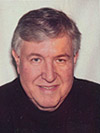| Home | Blog | Ask This | Showcase | Commentary | Comments | About Us | Contributors | Contact Us |

A tribute to a journalism innovator, and a look at the InternetSHOWCASE | March 87, 2008On the occasion of the retirement of Phil Meyer, the University of North Carolina's journalism school holds a two-day symposium pondering what the Internet hath wrought. By Barry Sussman I’ve known Phil Meyer the journalism innovator for a long time so I was delighted to get an invitation to ceremonies honoring his retirement as a professor at the University of North Carolina School of Journalism and Mass Communications. Turns out, it’s not just a retirement ceremony but a two-day symposium March 27th and 28th, with a reception and dinner March 30th inducting Phil in the school’s journalism hall of fame, an illustrious group. The symposium has a timely, scholarly title: “Raising the Ante: The Internet’s Impact on Journalism Education and Existing Theories of Mass Communication.” Guests like me were divided into nine groups and asked to write two-page papers in specific subject areas. In a prepared version of remarks he was to make, Meyer discussed “raising the ante” this way: “The hunter-gatherer model of journalism is no longer sufficient. Citizens can do their own hunting and gathering on the Internet. What they need is somebody to add value to that information by processing it – digesting it, organizing it, making it usable.” The title of my group’s subject was, “Goodbye, Mr. Gates.” An explanatory line—the subject four of us were asked to write about, was: “The speed with which awareness of a problem or issue diffused used to depend on a few decision makers. (Abe Rosenthal's suppression of the AIDS story is the textbook example.) Are the gatekeepers irrelevant now that the fences are down?” Here are descriptions and links to the other groups’ subject areas and individual papers: Internet Use and Community Ties: Keith Stamm (1985) established some connections between newspaper use and community ties. It is time to explore a possible parallel connection with the Internet, including the possible establishment of communities that are not geography based. Two-Step Flow: Lazarsfeld's 1940 discovery has been replicated many times, but little has been done to explore the role of the Internet in information that flows from media to opinion leaders and then to wider audiences. Should we now talk about a multi-step flow? Or a two-way flow? Agenda Setting: Replication of the 1968 work of Shaw and McCombs is planned for 2008. Who sets the agenda today? The mainstream media, the bloggers, PR practitioners? Cultivation: George Gerbner has shown that the scary, violent world of television drama is more real to the public than the actual world. As the Internet cuts into TV watching time, what will happen to his scary-world hypothesis and the cultivation effects of entertainment media. Minimal Effects: Since the 1950s we have rejected the idea that the media have immediate, direct, and powerful influence on their audiences. Should that be revisited in the light of recent cases involving YouTube, Facebook, and blogging. Diffusion Theory: Rogers and Shoemaker found that diffusion of innovation starts slowly, accelerates, then levels off - like the left half of the normal curve. With individuals exposed to so many more stimuli through the Internet, does a different pattern emerge or does it just develop faster? Uses and Gratifications: Which of the uses and gratifications of the traditional media can be transferred to Internet media? What does the Internet provide that the old media can't? Methodology: Survey research by telephone has run afoul of technology, but the Internet creates some new opportunities. Where are we headed? Click here for bios of those taking part in the symposium.
|



